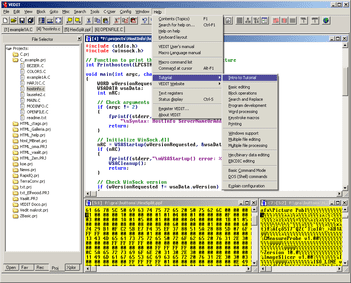Original author(s) Operating system | Developer(s) Greenview Data, Inc. Size ~2-6 MB | |
 | ||
Initial release 1980; 37 years ago (1980) Stable release 6.24.2 / January 12, 2015; 2 years ago (2015-01-12) | ||
Vedit is a commercial text editor for Z-80-based systems, Microsoft Windows and MS-DOS from Greenview Data, Inc.
Contents
Vedit was one of the pioneers in visual editing. It used a command set resembling TECO. Today, it is a powerful and feature-rich general-purpose text editor. Vedit can edit any file, including binary files and huge multi-gigabyte files. Still it is compact and extremely fast, perhaps because it is written mostly in Assembly language.
History
Vedit (Visual Editor) was created by Ted Green in 1979. It was commercially published by CompuView in 1980 for CP/M operating system running on 8080 / Z80 based computers. When the IBM-PC was introduced, Vedit was one of the first applications available for it in 1982. Versions of Vedit were available for MS-DOS, CP/M-86 and CSP DOS.
During the following years, versions were developed for OS/2, Xenix, SCO Unix and QNX. On QNX, Vedit was supplied as standard editor. Vedit was sold in three versions: Vedit Jr, Vedit and Vedit Plus. Later, the first two were dropped and Vedit Plus was renamed to just Vedit. CompuView was shut down in 1989, but a new company, Greenview Data, continued the development of Vedit starting from 1990. The first Windows version (Vedit Plus 5.0) was published in 1997. 32-bit Windows version (v5.1) was published in 1998. 64-bit Vedit Pro64 was published in 2003. It uses 64-bit addresses and data handling to support files larger than 2GB, but does not require a 64-bit processor or 64-bit OS.
Development and marketing of Unix, QNX etc. versions were gradually stopped. DOS-version has still been developed in parallel with Windows version and both have the same functions (as much as possible). DOS version is no longer sold separately or supported, but it is still packaged with the Windows versions. On February 2008, Greenview Data announced that the old CP/M and CP/M-86 versions of Vedit can be freely shared.
With version 6.20.1 (May 2011) the old Windows Help system was replaced with HTML Help system in to support 64-bit versions of Windows (Windows Vista, Windows 7, Windows 8/8.1 and Windows 10).
Technology
The DOS version of Vedit was written 100% in Assembly language. The exe file size is only 158k.
The Windows version was written mostly in Assembly, but the user interface has been written in C. The size of exe file is 573k, and no DLLs are used.
Vedit uses its own file buffering which is faster than the virtual memory of Windows. In addition, it uses very little of Windows' resources. When editing large files, only part of the file is loaded in the memory at a time and temporary files are created only as needed. Thus, dozens of gigabyte files can be open simultaneously on 32-bit Windows, and even a multi-gigabyte file is opened in a fraction of a second.
Therefore Vedit loads very fast and executes all operations fast. And since it does not utilize Windows resources, it does not slow down the other applications.
Features
Documentation
Vedit comes with comprehensive Online help and interactive Tutorial.
In addition, there are two PDF manuals: User's Manual (449 pages) and Macro Language Manual (305 pages). The manuals are available as printed books, too.
Greenview Data offers full email and phone support for customers. More support can be found from the User Forum.
